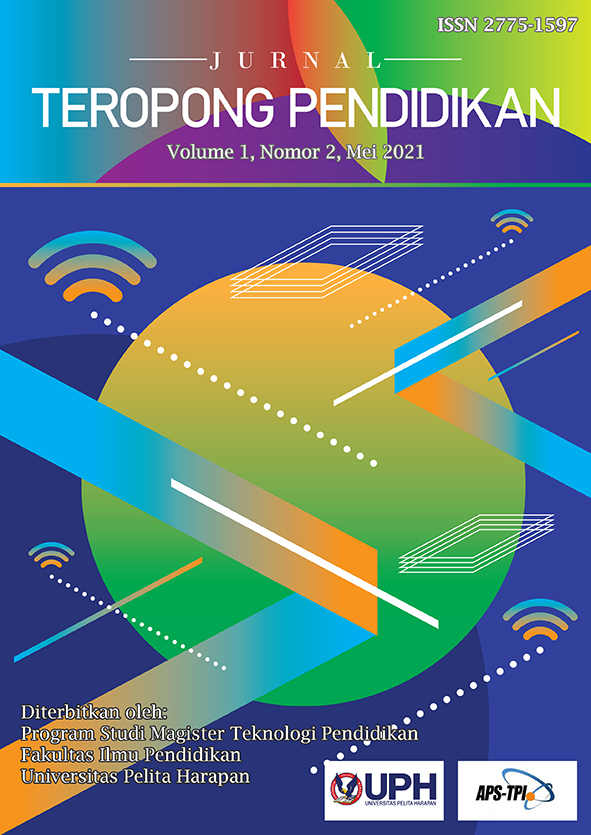MENINGKATKAN KETERAMPILAN MENULIS, KETERAMPILAN BERKOMUNIKASI LISAN, DAN MOTIVASI BELAJAR SISWA MELALUI PENDEKATAN PROSES MENULIS [IMPROVING WRITING SKILLS, ORAL COMMUNICATION SKILLS, AND STUDENT LEARNING MOTIVATION THROUGH THE WRITING PROCESS APPROACH]
DOI:
https://doi.org/10.19166/jtp.v1i2.3457Schlagworte:
Writing process approach, writing skills, oral communication skills, learning motivationAbstract
The writing process approach is used to help students to write more competently through stages of the approach. The design of Static-Group Pretest-Postest is used to investigate the increase on students' writing skills, oral communication skills and learning motivation in Indonesian classes. The subject of the study was 41 Grade 8 students consisting of 21 students in experiment group and 20 students in control group. The study was conducted by implementing the writing process approach as the treatment in experiment class and conventional approach in the control class. The data was analysed using descriptive statistics and Wilcoxon test by comparing the results between pretest and posttest, and Mann Whitney test was used to find the difference between two groups. The findings show that there were increase on writing skills in middle category (N gain =0.48; p =0.000), oral communication skills in middle category (N gain = 0,47; p = 0,000), and learning motivation in low category (N gain = 0,25; p = 0,000) after the implementation of the writing process.
Literaturhinweise
Barnett, M. A. (1989). Writing as a process. The French Review, 63(1), 31-44. https://www.jstor.org/stable/394684
Clark, I. L. (2002). Concepts in composition: Theory and practice in the teaching of writing. Routledge. https://doi.org/10.4324/9781410606785
Cotton, K. (2016, November 17). Teaching composition: Research on effective practices. University of Hawai’i. http://www.hawaii.edu/mauienglish/department/pages/Teaching_composition.pdf
Fraenkel, J. R., Wallen, N. E., & Hyun, H. H. (2011). How to design and evaluate research in education. McGraw-Hill.
Friedrich G. W., Wiemann, J. M., & Wiemann, M. O. (1997). Competent communication. St. Martin’s Press.
Hargie, O. (2006). The handbook of communication skills. Routledge. https://doi.org/10.4324/9780203007037
Kadir. (2015). Statistika terapan, konsep, contoh dan analisis data dengan program SPSS/Lisrel dalam penelitian. Rajawali Pers.
Middle Years Programme. (2014). MYP: From principles into practice. International Baccalaureate Organization (UK) Ltd.
Purnamikautami, I. G. A. L. (2011). The effect of peer assessment of students’ writing achievement with differing achievement motivation. Jurnal Ilmiah Pendidikan dan Pembelajaran Ganesha. https://www.neliti.com/publications/96938/the-effect-of-peer-assesment-on-students-writing-achievement-with-differing-achi
Purwandari, S. (2012). Upaya meningkatkan keterampilan menulis karangan narasi dengan penggunaan media gambar seri pada siswa kelas IV SD Mangir Lor Kecamatan Pajangan Kabupaten Bantul. [S1 Thesis, Universitas Negeri Yogyakarta]. Lumbung Pustaka UNY. https://eprints.uny.ac.id/9902/
Rosidi, I. (2009). Siapa takut menulis? Panduan bagi penulis pemula. Kanisius.
Santrock, J. W. (2008). Psikologi pendidikan. Kencana.
Sun, C., & Feng, G. (2009). Process approach to teaching writing applied in different teaching models. English Language Teaching, 2(1), 150-155. https://doi.org/10.5539/elt.v2n1p150
Tarigan, H. (2015). Berbicara sebagai suatu keterampilan berbahasa (Rev. ed.). Angkasa.
Tompkins, G. E. (1999). Literacy for the twenty-first century: A balanced approach. Merrill.
Wery, J., & Thomson, M. M. (2013). Motivational strategies to enhance effective learning in teaching struggling students. Support for Learning, 28(3), 103-108. https://doi.org/10.1111/1467-9604.12027
Wiryanto. (2004). Pengantar Ilmu Komunikasi. Grasindo.
Downloads
Veröffentlicht
Ausgabe
Rubrik
Lizenz
Authors who publish with this journal agree to the following terms:
1) Authors retain copyright and grant the journal right of first publication with the work simultaneously licensed under a Creative Commons Attribution License (CC-BY-SA 4.0) that allows others to share the work with an acknowledgement of the work's authorship and initial publication in this journal.
2) Authors are able to enter into separate, additional contractual arrangements for the non-exclusive distribution of the journal's published version of the work (e.g., post it to an institutional repository or publish it in a book), with an acknowledgement of its initial publication in this journal.
3) Authors are permitted and encouraged to post their work online (e.g., in institutional repositories or on their website). The final published PDF should be used and bibliographic details that credit the publication in this journal should be included.





